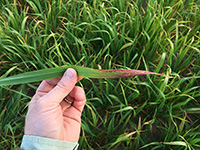From what’s being observed in some south Georgia pastures this fall, oats are struggling, with growers seeing issues from cold damage, nutrient and moisture stress, and possible barley yellow dwarf virus. Above-average rainfall in November and December have also prevented cattle from getting into oat pastures for winter grazing.
Farmers have observed older, lower leaves on oat plants turning off-color due to unseasonably cold temperatures in south Georgia. Oats are particularly vulnerable to freezing temperatures, and when temperatures start to drop, anthocyanins (pigments that give plants their color) collect in the plant and cause a purplish color.
In the absence of cold weather, this color can be attributed to phosphorous deficiency or, more concerning, as an early warning symptom of barley yellow dwarf virus, which can also cause this purple color in oats. University of Georgia Cooperative Extension Professor David Buntin confirms that the virus has been more prevalent throughout the state.
The virus is vectored by the bird cherry-oat aphid and growers who suspect infection should have lab test to confirm the virus.
It’s important to remember that oats are more susceptible to the barley yellow dwarf virus than any other small grain. Although recent colder temperatures in south Georgia will reduce how active the aphids are, and a hard freeze could kill off aphid populations, very high aphid populations could migrate low to the ground and survive.
UGA Extension offers the following tips for farmers who are concerned about oat crop health:
- If oats are highly infected with barley yellow dwarf virus, it is not likely an insecticide will be of any benefit.
- If oats do not appear infected with barley yellow dwarf virus and aphids are present, an insecticide will be of benefit.
- If oats do not appear infected with barley yellow dwarf virus and aphids are not present, scout the field for aphids.
For more on growing small grains in Georgia, visit http://extension.uga.edu/topic-areas/field-crop-forage-turfgrass-production/small-grains.html.
To read more about agriculture in Wilcox County, Georgia, see https://site.extension.uga.edu/wilcoxcoag/2017/10/new-county-agent/.




.png)


